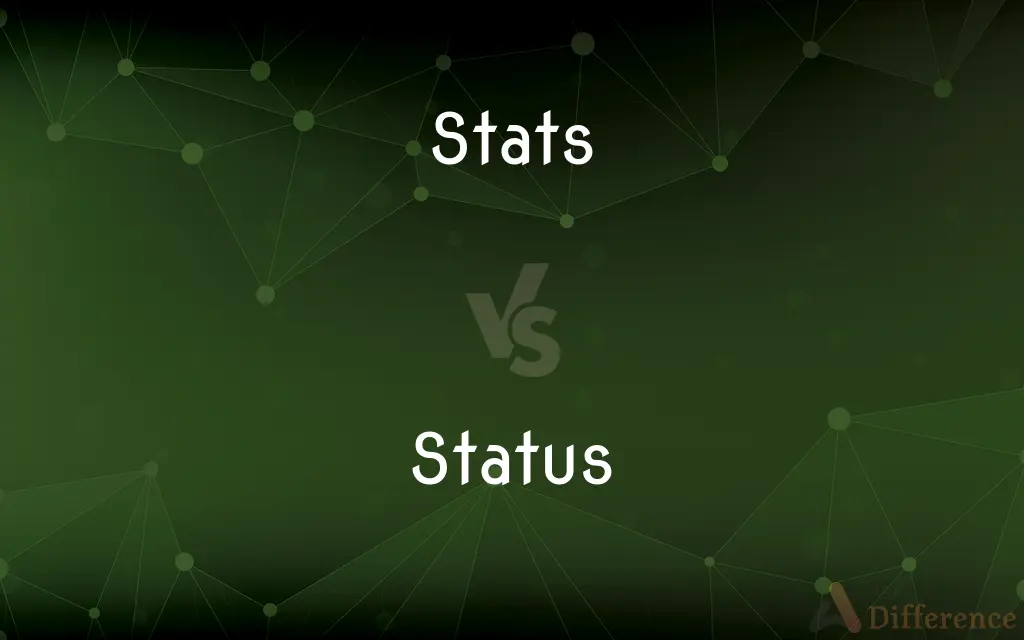Stats vs. Status — What's the Difference?
By Urooj Arif & Fiza Rafique — Updated on March 29, 2024
Stats refer to numerical data or figures summarizing information, while status denotes a condition or situation of a person, object, or phenomenon at a specific time.

Difference Between Stats and Status
Table of Contents
ADVERTISEMENT
Key Differences
Stats, short for statistics, encompass quantitative data or figures that provide insights into various aspects of subjects or situations, such as performance metrics in sports, demographics, or economic indicators. These figures are often used to analyze trends, make comparisons, or support decision-making processes. On the other hand, status pertains to the current state, condition, or position of someone or something, often reflecting its relative standing, progress, or situation within a specific context.
While stats offer a numerical representation that can help in understanding patterns, behaviors, or outcomes over time, status provides a snapshot of a particular moment, giving immediate insight into the condition or standing of the subject in question. For example, a company's stats might include sales figures, growth rates, and market share, which collectively provide a detailed picture of its performance over time, whereas its status could refer to its current market position or operational state, such as "active," "under review," or "expanding."
Stats are typically collected through surveys, experiments, or records and are analyzed using statistical methods to draw conclusions or make predictions. Status, however, can be described without numerical data, often conveyed through descriptive terms, classifications, or categories.
Understanding the distinction between stats and status is crucial in various fields, from sports and health care to business and technology, as it affects how information is interpreted and decisions are made. Stats help in the long-term analysis and strategic planning by providing a detailed overview through numbers, while status offers an immediate understanding of a situation, which is essential for timely decision-making or assessments.
In practical terms, while you might look at a player's stats to evaluate their performance over a season, you'd check their status to see if they are currently available, injured, or suspended for an upcoming game. Similarly, in a business context, analyzing sales stats gives insight into trends and performance metrics, but knowing the current status of a project is critical for immediate planning and resource allocation.
ADVERTISEMENT
Comparison Chart
Definition
Numerical data summarizing information
The current condition or situation
Purpose
To analyze trends, make comparisons
To describe current standing or condition
Representation
Quantitative, often in charts or graphs
Descriptive, can be qualitative or categorical
Usage
Long-term analysis, strategic planning
Immediate understanding, decision-making
Examples
Performance metrics, demographics
Operational state, progress reports
Compare with Definitions
Stats
Indicators or measures of performance or trends.
The company's quarterly stats indicated a growth in sales.
Status
The operational state of a device or system.
The system's status is displayed as 'operational'.
Stats
Demographics or statistical data for research.
Population stats were used to plan the city's resources.
Status
The legal or social position of a person or entity.
The company's status as a non-profit affects its tax filings.
Stats
Figures or data collected for analysis.
Economic stats show an increase in employment rates.
Status
A description of one's current situation or position.
Her status as a leading researcher is well recognized.
Stats
Performance metrics in sports or other fields.
Her batting stats were the best on the team this season.
Status
The current condition or state of someone or something.
The project's status is 'in progress'.
Stats
Quantitative data summarizing aspects of a subject.
The player's stats include goals scored and assists.
Status
A classification indicating a current phase or condition.
The order status is 'shipped'.
Stats
A statistic.
Status
Relative social or professional position; standing
An improvement in the status of women
Stats
Clipping of statistics(the subject)
Stats is one of her favourite subjects at school.
Status
The situation at a particular time during a process
An update on the status of the bill
Stats
Clipping of statistics(data, figures)
What do the stats tell us?
Status
Position relative to that of others; standing
Her status is that of a guest.
Stats
Attributes of a unit in a game (e.g. health, damage output)
Those items he bought really boosted his stats.
Status
High standing; prestige
A position of status in the community.
Stats
Shortened form of statistics{2} (b).
Status
(Law) The legal character or condition of a person or thing
The status of a minor.
Status
The state of affairs; the situation
What is the status of the negotiations?.
Status
A person’s condition, position or standing relative to that of others.
Superstition is highly correlated with economic status.
Status
Or high standing.
Status
A situation or state of affairs.
What's the status of the investigation?
New York is known for its status as a financial center.
Status
(legal) The legal condition of a person or thing.
Status
The state (of a Canadian First Nations person) of being registered under the Indian Act.
He is a status Indian.
Status
(social networking) A function of some instant messaging applications, whereby a user may post a message that appears automatically to other users, if they attempt to make contact.
I'm just about to update my status to "busy".
Status
(medicine) Short for status asthmaticus.}}
Status
State; condition; position of affairs.
Status
The relative position or standing of things or especially persons in a society;
He had the status of a minor
The novel attained the status of a classic
Atheists do not enjoy a favorable position in American life
Status
A state at a particular time;
A condition (or state) of disrepair
The current status of the arms negotiations
Common Curiosities
What are stats used for?
Stats are used for analyzing trends, comparing performance, and supporting decision-making through numerical data.
What is the significance of status in business?
In business, status is significant for assessing the current operational state, project progress, and making immediate decisions.
How are stats collected?
Stats are collected through surveys, records, experiments, and other methods of gathering quantitative data.
What does status indicate?
Status indicates the current condition, situation, or standing of a person, object, or phenomenon.
Why is knowing the status important in management?
Knowing the status is crucial in management for immediate decision-making, resource allocation, and assessing progress or needs.
Can an individual's status be quantified?
An individual's status is more qualitative, reflecting their condition or position, though it can be influenced by quantifiable attributes.
Can stats change a status?
Yes, changes in stats can lead to changes in status, as they provide data that might affect decision-making or perceptions.
Is status static or dynamic?
Status is dynamic, as it can change over time depending on circumstances, decisions, or events.
How is status communicated in organizations?
Status is communicated through reports, updates, meetings, or digital systems designed to track and share the current state of affairs.
What role do stats play in research?
In research, stats play a critical role in data analysis, hypothesis testing, and drawing conclusions based on quantitative data.
Are stats always numerical?
Yes, stats are inherently numerical as they represent data in figures or quantitative forms.
How do stats affect strategic planning?
Stats affect strategic planning by providing a basis for analysis, identifying trends, and helping to forecast future scenarios.
Can status be described without numbers?
Yes, status can be described without numbers, often through descriptive terms, categories, or classifications.
Do stats require interpretation?
Yes, stats require interpretation through statistical analysis to understand their significance and implications.
How do stats relate to performance?
Stats are often used to measure and analyze performance, providing insights into effectiveness, efficiency, and outcomes.
Share Your Discovery

Previous Comparison
Concrete vs. Mud
Next Comparison
Hasp vs. LatchAuthor Spotlight
Written by
Urooj ArifUrooj is a skilled content writer at Ask Difference, known for her exceptional ability to simplify complex topics into engaging and informative content. With a passion for research and a flair for clear, concise writing, she consistently delivers articles that resonate with our diverse audience.
Co-written by
Fiza RafiqueFiza Rafique is a skilled content writer at AskDifference.com, where she meticulously refines and enhances written pieces. Drawing from her vast editorial expertise, Fiza ensures clarity, accuracy, and precision in every article. Passionate about language, she continually seeks to elevate the quality of content for readers worldwide.














































